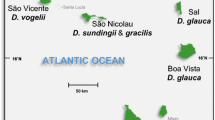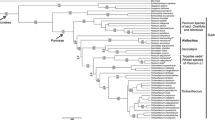Abstract
Morphological and ITS sequence divergence were assessed between the two presently recognized taxa of the endemic genusCuminia (Lamiaceae), on Masatierra of the Juan Fernandez Islands. Morphological studies were based on leaf morphology of 51 individuals. Individuals ofC. fernandezia have narrow and lanceolate leaves with cuneate to acute bases and apices, whereas individuals ofC. eriantha have broadly ovate leaves with rounded bases and acute to obtuse apices. The two taxa can also be distinguished by the presence of pubescence.Cuminia eriantha has hairs on the leaves, young stems, floral peduncles, calyx, and corolla. Alternatively,C. fernandezia is glabrous except for tuft hairs on the nodes, and hairs on calyx teeth and corolla tubes. The ITS 1 and 2 regions of the five plants ofCuminia sequenced are a total of 451 bp long. All plants have identical ITS-1 but pubescent and glabrous plants are consistently different in ITS-2 sequence, revealing 1.3% total sequence divergence between the species. Both morphological and molecular data support the taxonomic recognition of two taxa, and the small but consistent differences appear to justify species status for the two entities. The pubescent populations representC. eriantha and the glabrous ones areC. fernandezia. It is hypothesized that the species diverged from a common ancestral immigrant to the islands, when Masatierra was much larger and more ecologically diverse than it now is. The two taxa seem to maintain their identities with no evidence of hybridization, even though they often grow in close proximity to one other on the island. Each population consists only of glabrous or pubescent plants, with no mixed population detected.
Similar content being viewed by others
Literature Cited
Baldwin, B. G. 1992. Phylogenetic utility of the internal transcribed spacers of nuclear ribosomal DNA in plants: an example from the Compositae. Molec. Phylogenet. Evol. 1: 36.
Bentham, G. 1835. Labiatarum genera et species: or, a description of the genera and species of plants of the order Labiatae. London.
Bentham, G. 1848. Labiatae,Cuminia. In: A. L. P. de Candolle. Prodromus systematis naturalis regni vegetabilis 12: 258.
Colla, L. A. 1835. Plantae rariores in regionibus chilensibus a clarissimo. Mem. Reale Accad. Sci. Torino 38: 117–141.
Cosner, M. B., R. K. Jansen &T. G. Lammers. 1994. Phylogenetic relationships in the Campanulales based onrbcL sequences. Pl. Syst. & Evol. 190: 79–95.
Crawford, D. J., T. F. Stuessy &M. Silva O. 1986. Leaf flavonoid chemistry and the relationships of the Lactoridaceae. Pl. Syst. & Evol. 153: 133–139.
—,S. Brauner, M. B. Cosner &T. F. Stuessy. 1993. Use of RAPD markers to document the origin of the intergeneric hybrid ×Margyricaena skottsbergii (Rosaceae) on the Juan Fernandez Islands. Amer. J. Bot. 80: 89–92.
—,T. F. Stuessy, M. B. Cosner, D. W. Haines, D. Wiens &P. Peñailillo. 1994.Lactoris fernandeziana (Lactoridaceae) on the Juan Fernandez Islands: allozyme uniformity and field observations. Conserv. Biol. 8: 277–280.
—,T. Sang, T. F. Stuessy, S. Kim &M. Silva. 1998.Dendroseris (Asteraceae: Lactuceae) andRobinsonia (Asteraceae: Senecioneae) on the Juan Fernandez Islands: similarities and differences in biology and phylogeny. Pages 97–119.In: T. Stuessy & M. Ono, editors. Evolution and speciation of island plants. Cambridge University Press, Cambridge.
Doyle, J. J. &J. L. Doyle. 1987. A rapid DNA isolation procedure for small quantities of fresh leaf tissue. Phytochem. Bull. 19: 11–15.
Epling, C. 1937. The Labiatae of Chile. Revista Univ. (Santiago) 22(1): 167–194.
Harley, R. 1986.Cuminia eriantha Labiatae. Kew Mag. 3(4): 151–156.
Johow, F. 1896. Estudios sobre la flora de Juan Fernandez. Gobierno de Chile, Santiago.
Kim, K.-J. &R. K. Jansen. 1994. Comparison of phylogenetic hypotheses among different data sets in dwarf dandelions (Krigia): additional information from internal transcribed spacer sequences of nuclear ribosomal DNA. Pl. Syst. & Evol. 190: 157–185.
Lammers, T. G., T. F. Stuessy &M. Silva O. 1986. Systematic relationships of the Lactoridaceae, an endemic family of the Juan Fernandez Islands, Chile. Pl. Syst. & Evol. 152: 243–266.
Marticorena, C., T. F. Stuessy &C. M. Baeza. 1998. Catalogue of the vascular flora of the Robinson Crusoe Islands, Chile. Gayana, Bot. 55: 187–211.
Pacheco, P., T. F. Stuessy &D. J. Crawford. 1991. Natural interspecific hybridization inGunnera (Gunneraceae) of the Juan Fernandez Islands, Chile. Pacific Sci. 45: 389–399.
Sanders, R. W., T. F. Stuessy &R. Rodríguez. 1983. Chromosome number from the flora of the Juan Fernandez Islands. Amer. J. Bot. 70: 799–810.
——,C. Marticorena &M. Silva. 1987. Phytogeography and evolution ofDendroseris andRobinsonia tree Compositae of the Juan Fernandez Islands. Opera Bot. 92: 195–215.
Sang, T., D. J. Crawford, S. Kim &T. F. Stuessy. 1994. Radiation of the endemic genusDendroseris (Asteraceae) on the Juan Fernandez Islands: evidence from sequences of ITS regions of nuclear ribosomal DNA. Amer. J. Bot. 81: 1494–1501.
——,T. F. Stuessy &M. Silva. 1995. ITS sequences and the phylogeny of the genusRobinsonia (Asteraceae). Syst. Bot. 20: 55–64.
Skottsberg, C. 1922. The phanerogams of the Juan Fernandez Islands. Pages 95–240.In: C. Skottsberg, editor. The natural history of Juan Fernandez and Easter Islands. Vol. 2. Almqvist & Wiksells, Uppsala.
— 1951. Supplement to the pteridophytes and phanerogams of Juan Fernandez Islands. Pages 763–792.In: C. Skottsberg, editor. The natural history of Juan Fernandez and Easter Islands. Vol. 2. Almqvist & Wiksells, Uppsala.
Stuessy, T. F., K. A. Foland, J. F. Sutter, R. W. Sanders &M. Silva. 1984. Botanical and geological significance of potassium-argon dates from the Juan Fernandez Islands. Science 225: 49–51.
—,C. Marticorena, R. Rodriguez, D. J. Crawford &M. Silva. 1992. Endemisms in the vascular flora of the Juan Fernandez Islands. Aliso 13: 297–307.
—,D. J. Crawford, T. Sang &R. Rodriguez. 1994. Morphological and molecular divergence between the two species ofRhaphithamnus (Verbenaceae). Amer. J. Bot. (6, suppl.): 190.
——,G. J. Anderson &R. J. Jensen. 1998a. Systematics, biogeography and conservation of Lactoridaceae. Perspect. in Pl. Ecol. Evol. & Syst. 1(2): 1–24.
——,C. Marticorena &M. Silva. 1998b. Isolating mechanisms and modes of speciation in endemic angiosperms of the Juan Fernandez Islands. Pages 79–96.In: T. Stuessy & M. Ono, editors. Evolution and speciation of island plants. Cambridge University Press, Cambridge.
——— &R. Rodriguez. 1998c. Island biogeography of angiosperms of the Juan Fernandez archipelago. Pages 121–138.In: T. Stuessy & M. Ono, editors. Evolution and speciation of island plants. Cambridge University Press, Cambridge.
—,U. Swenson, C. Marticorena, O. Matthei &D. J. Crawford. 1998d. Loss of plant diversity and extinction on Robinson Crusoe Islands, Chile. Pages 243–257.In: C.-I. Peng & P. P. Lowrey, editors. Rare, threatened, and endangered floras of Asia and the Pacific rim. Academia Sinica Monograph Series no. 16. Institute of Botany, Academia Sinica, Taipei.
Sun, B. Y., A. M. Humaña, D. J. Crawford &M. Riveros. 1996. Evolution ofRhaphithamnus venustus (Verbenaceae), a gynodioecious hummingbird-pollinated endemic of Juan Fernandez Islands, Chile. Pacific Sci. 50: 55–65.
Wallace, A. R. 1880. Island life, or the phenomena and causes of insular faunas and floras, including a revision and attempted solution of the problem of geological climates. Macmillan, London.
White, T. J., T. Bruns, S. Lee &J. Taylor. 1990. Amplification and direct sequencing of fungal ribosomal RNA genes for phylogenetics. Pages 315–322.In: M. Innis, D. Gelfand, J. Sninsky & T. White, editors. PCR protocols; a guide of methods and applications. Academic Press, San Diego.
Whittaker, R. J. 1998. Island biogeography: ecology, evolution, and conservation. Oxford University Press, Oxford.
Yokota, Y., T. Kawata, Y. Iida, A. Kato &S. Tanifuji. 1989. Nucleotide sequences of the 5.8S rRNA gene and internal transcribed spacer regions in carrot and broad bean ribosomal DNA. J. Molec. Evol. 29: 294–301.
Author information
Authors and Affiliations
Rights and permissions
About this article
Cite this article
Ruiz, E., Marticorena, C., Crawford, D. et al. Morphological and ITS sequence divergence between taxa of Cuminia (Lamiaceae), an endemic genus of the Juan Fernandez Islands, Chile. Brittonia 52, 341–350 (2000). https://doi.org/10.2307/2666587
Issue Date:
DOI: https://doi.org/10.2307/2666587




